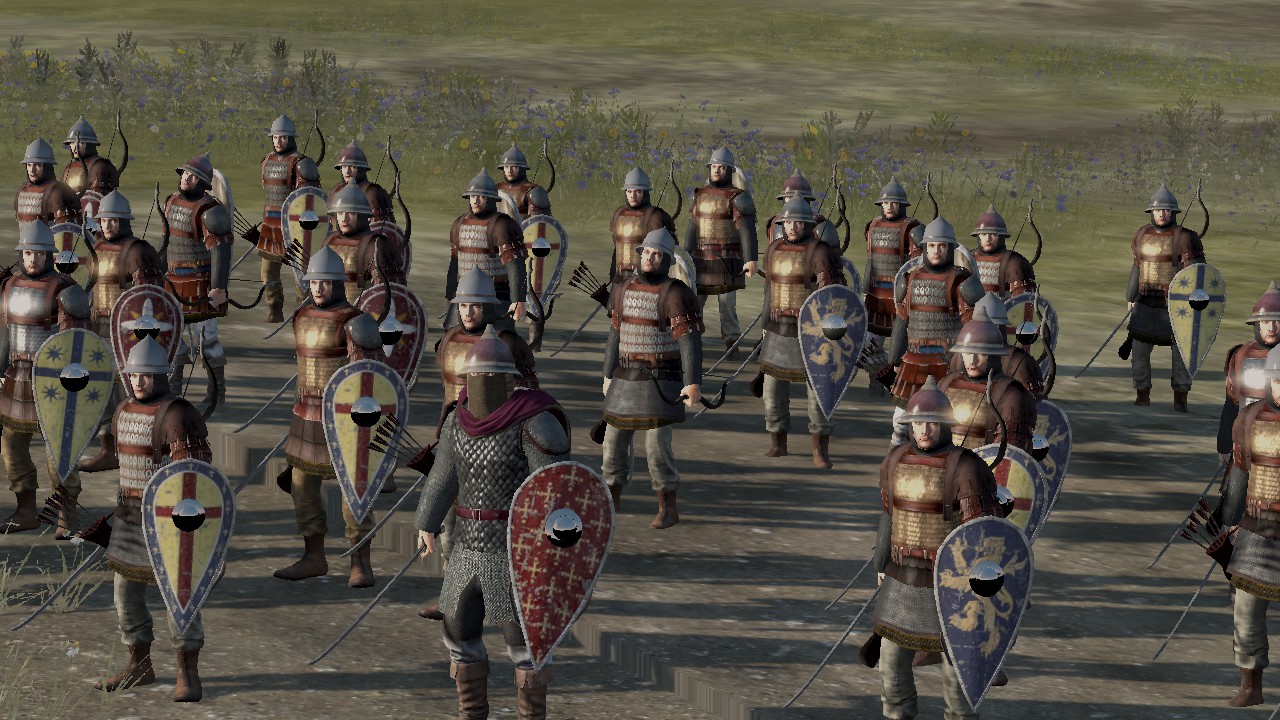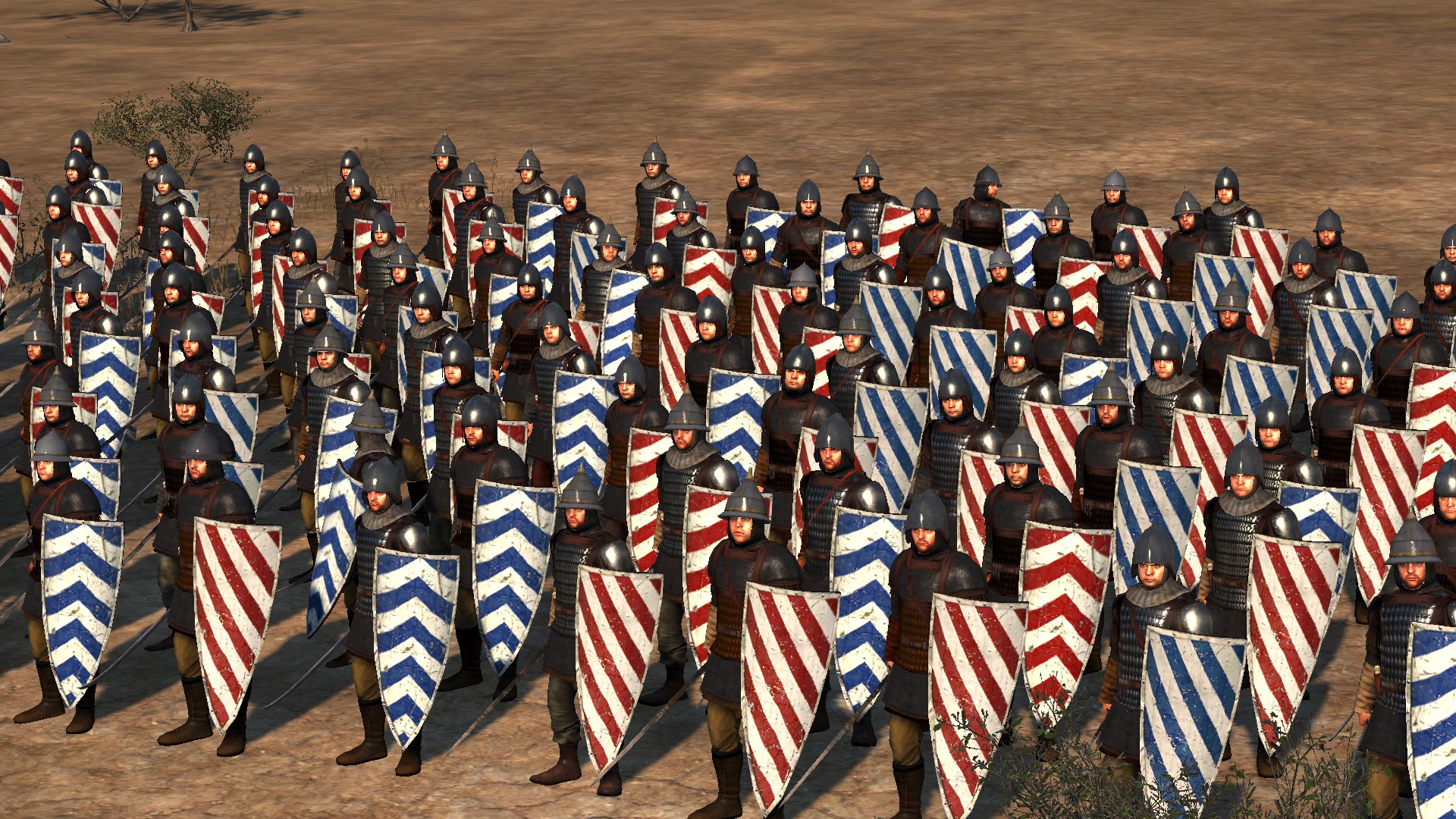

- MEDIEVAL TOTAL WAR 1 BYZANTINE INFANTRY MANUALS
- MEDIEVAL TOTAL WAR 1 BYZANTINE INFANTRY MANUAL
- MEDIEVAL TOTAL WAR 1 BYZANTINE INFANTRY PROFESSIONAL
The turma, on the hand, comprised around three moirai, thus amounting to around 3,000 men. To that end, a moira often contained variable numbers of banda, oscillating between 2 to 5 – possibly accounting for around 1,000 troops in the 10th century AD (as opposed to the norm of 2,000 men for each moirai in the 6th century AD). The banda (plural of bandon) was also used as the standard for determining bigger divisions, like moirai and turmai. Interestingly enough, the Byzantine army did make use of ‘mixed’ divisions of soldiers within each bandon, with ratios of 3:1 to 7:3 when it came to spearmen ( skutatoi) and archers, thus suggesting advanced tactical deployments on the battlefields. In any case, on the theoretical level, by Emperor Leo’s time, a bandon possibly accounted for 256 men for infantrymen (comprising sixteen lochaghiai) and 300 men for cavalry (comprising six allaghia of 50 men each) – and each one was commanded by a komes or count. Now it should be noted that the number of troops within each bandon varied in accordance with the available manpower, which took into account the injured and the invalidated.

MEDIEVAL TOTAL WAR 1 BYZANTINE INFANTRY MANUALS
And both of these manuals talked about the basic military unit of bandon (or tagmata as mentioned in Strategicon), a word itself derived from the Germanic ‘banner’, thus alluding to the foreign influence in Byzantine army during the early medieval period.
MEDIEVAL TOTAL WAR 1 BYZANTINE INFANTRY MANUAL
The military manual of Strategicon (Greek: Στρατηγικόν) written by Eastern Roman Emperor Maurice in the late 6th century dealt with the general military strategies, and the renowned Tactica military treatise written by or on behalf of Byzantine Emperor Leo VI the Wise (circa early 10th century AD), drew heavily from this handbook. Organization of the Byzantine Army – Bandon – The Basic Unit of the Eastern Roman Army Byzantine Themata cavalry, circa 7th-8th century AD. And this scope of professionalism was rather reinforced by the favorable economic might of the empire, strengthened by an organized military system (that was different from their ancient Roman predecessors) and well-defined logistical support.
MEDIEVAL TOTAL WAR 1 BYZANTINE INFANTRY PROFESSIONAL
Simply put, the Byzantine army from this particular epoch was the closest to a professional force that served any known medieval realm. However, as historian Ian Heath wrote (in Byzantine Armies 886-1118 AD) – in spite of such misunderstood labeling and anachronistic slanders, the Byzantine army of 10th century AD was possibly the “ best-organized, best-trained, best-equipped and highest-paid in the known world”. In essence, such biased views were often concocted by the contemporaries of the Eastern Roman Empire, who perceived the political scope and ploys favored by the Romans as being overly complicated and labyrinthine. In fact, to that end, the word ‘Byzantine’ is rather deprecatory even in our modern world, with its association often made to “deviousness or underhand procedure” ( Oxford Dictionary). Source: Wikimedia CommonsĪs we mentioned before, the term ‘Byzantine’, as opposed to Eastern Roman, is rather a medieval invention that sort of takes an uncomplimentary route – partially based on the prejudices of medieval chroniclers. Introduction – The Overshadowing of Military by Politics Leo Phokas defeats Sayf ud-Dawla at Adrassos. Note* – In spite of its slightly fallacious nature, we will continue to use the term ‘Byzantine’ instead of ‘Eastern Roman’ in the following article, for the sake of clarity (for most readers). So without further ado, let us delve into the history, organization, and evolution of the early medieval (Eastern Roman) Byzantine army, from circa 7th to 11th century.

To that end, the very term ‘Byzantine’ in spite of its popularity, is a misleading word. But if we take the impartial route that is ‘bereft’ of prejudiced medieval European politics and chronicling, the Byzantine Empire was the continuation (and even represented endurance) of the Roman legacy, so much so that most of its citizens called their realm Basileia tôn Rhōmaiōn – the Roman Empire. Popular notions tend to group the later Eastern Roman realm, or more specifically the Byzantine Empire, as a strictly medieval entity that encompassed Greece, the surrounding Balkans, and the Anatolian landmass.


 0 kommentar(er)
0 kommentar(er)
